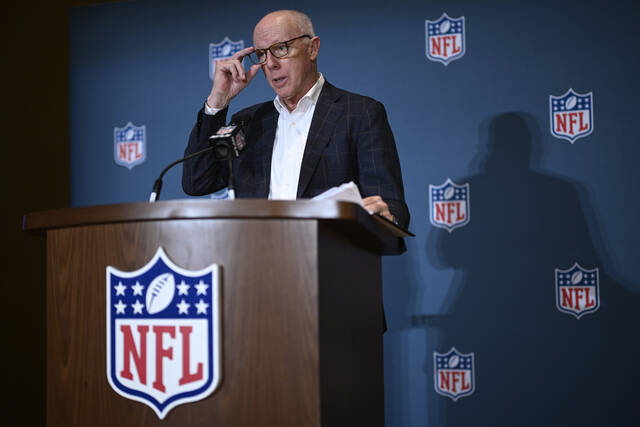Steelers have change of heart on kickoff rule, vote in favor of radical concept
Share this post:
ORLANDO, Fla. — Initially opposed to the NFL’s new hybrid kickoff rule, Pittsburgh Steelers president Art Rooney II was swayed by popular opinion Tuesday at the league’s annual meetings.
The Steelers were one of 29 teams that approved the rule change that was adopted at the NFL annual meeting. Three teams voted against the proposal, which puts every player except for the kicker on the same side of the 50-yard line and eliminates the “surprise” onside kick.
“We wound up voting for it after it was a foregone conclusion that it was going to pass,” Rooney II said after the meetings wrapped up at the Ritz-Carlton resort.
He didn’t enter the meetings with that mindset, saying “there was not a lot of enthusiasm to start.”
The rules change, which is for one year and will be revisited next spring, is the most significant involving special teams since the extra point was pushed back to the 15-yard line in 2015.
“It’s a dramatic change, no way around that,” Rooney said. “We had some reservations because of that. It’s going to be interesting.”
The NFL just passed a new kickoff rule that will look like this, per @AdamSchefter
pic.twitter.com/VcQs7QrSto— Bleacher Report (@BleacherReport) March 26, 2024
Proving that the NFL is indeed a copycat league, the hybrid kickoff was based on the technique used the past two seasons by the XFL. The goal for the NFL was to eliminate the number of collisions on kickoffs that took place because of the speed and expanded space involved in the play.
The competition committee also wanted to make the play more meaningful after seeing a Mt. Washington-sized increase in touchbacks in recent seasons. Every kickoff in the Super Bowl resulted in a touchback, with 12 of the 13 kicks going out of the end zone.
“It’s taking a play that has been dying and reviving it,” said New Orleans Saints special teams coordinator Darren Rizzi, who helped shape the rule in consultation with other coaches.
The ball will continue to be kicked off from the 35-yard line. The other 10 players on the kicking team will line up at the opposing 40. Members of the return unit will set up between the 30-35 in the setup zone. The returners — maximum of two — will be stationed in the landing zone, which starts at the goal line and ends at the 20.
No player movement is permitted until the ball is caught or touches the ground. A touchback will result in the ball being placed at the 30 instead of the 35 as originally proposed by the competition committee. A touchback in which the ball hits in the landing zone and rolls out of the end zone will give possession at the 20.
Atlanta Falcons CEO Rich McKay, the head of the competition committee, saw the proposal gain momentum when the touchback was moved to the 30.
“This will definitely reduce the number of returns, from 80-90% to 50-60%,” he said. “That is OK with us to start. We just felt like that was a good compromise.”
The kickoff resulted in 1,970 touchbacks and 92 fair catch calls in 2023.
“Even if we get to a 50% rate, we’re bringing back about 1,000 plays into the fold,” Rizzi said. “It’s going to be must-see TV because it’s new to everybody.”
The onside kick isn’t disappearing from the game entirely, just for the first three quarters. Teams may elect to try as many as two onside kicks in the fourth quarter by using the traditional kickoff formation.
Data showed that just two surprise onside kicks were attempted last season, with the kicking team recovering neither of the attempts.
In addition, any kickoff falling short of the landing zone — the area before the 20-yard line — will result in a dead ball with possession starting at the 40. That means the elimination of squib kicks that often take place in the final seconds of each half to help run down the clock.
McKay believes the benefits outweigh any reservations that owners, general managers and coaches had about the rules change.
“We are in the business of creating an entertaining product,” he said. “It’s putting a product on the field that should be competitive in every moment, and we created a play (before) that was no longer competitive. This, in our opinion, was our best option. Yes, it’s a big change, but it’s time to make that change.”
Other changes that were adopted:
• As outlined in a proposal presented by the Steelers, the annual trading deadline has been pushed back a week. It will take place the Tuesday after the ninth week of games, putting it at the midpoint of the 18-week schedule.
• The emergency third quarterback no longer must be on the 53-man roster. A quarterback can be promoted from the practice squad as one of a team’s two weekly elevations. This quarterback can be elevated an unlimited number of times during the year.


